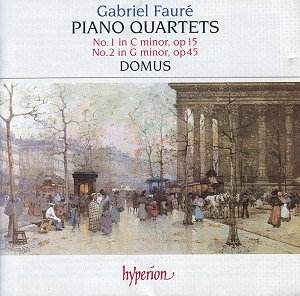This disc comes garlanded with prestigious international awards and recommendations for the original release (CDA66166), recorded in 1985 and now reissued in this limited edition. Little need be added to what has already written about the superlative qualities of the first recording, which remastering may well have enhanced, and I am therefore left with the more difficult task of discussing the works themselves.
Compared with his French contemporaries Fauré was no extrovert. His textures are refined and delicate, and the music often has an inward-looking quality far removed from the vivid impressionism of Debussy and Ravel. If influences are sought, those of Saint-Saëns and César Franck come readily to mind, though Fauré's chromaticism and - especially in these Quartets - imaginative development of thematic material are very much his own. Though widely separated by their opus numbers, both are remarkably consistent in structure and in style
Despite its dark C minor tonality the first Quartet could hardly be called dramatic. Its mood is intimate - often playfully so - and the first movement, Allegro molto moderato, is largely unshadowed by deeper emotions. The vivacious Scherzo that follows it leaves us unprepared for the introspection of the fine Adagio. A final Allegro molto returns to the prevailing good humour of the opening movement.
Both are fairly substantial works (37.97 and 28.27 respectively), and the only difficulty the second Quartet likely to present to anyone unfamiliar with Fauré's daring counterpoint and inventive elaborations is keeping track of what's happening. The piano is prominent, and Susan Thomas effortlessly maintains a supple balance within this talented ensemble. Widely regarded as the better of the two works, Fauré takes the music into remote keys and often strays into melodic byways, which may leave some listeners (including me) wondering where this is all leading. The answer, of course, being wherever the composer wishes to take us. Admirers of Fauré's melodic gifts and intricate style will luxuriate in these examples of his capacity to make understatement a virtue in itself.
Roy Brewer

![]() Domus Quartet.
Domus Quartet. ![]() Hyperion CDA20166 Limited
Edition [62.13]
Hyperion CDA20166 Limited
Edition [62.13]